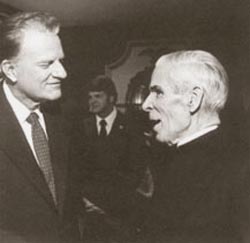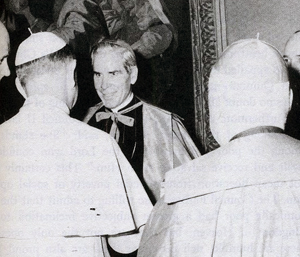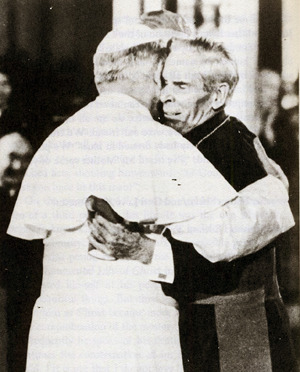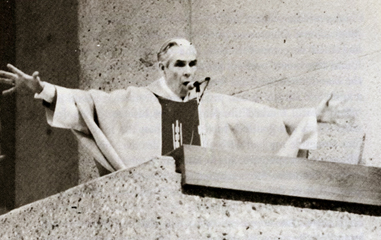 |
Traditionalist Issues
Archbishop Sheen,
an Enthusiast of Vatican II
Marian T. Horvat, Ph.D.
TIA recently received the following correspondence from one of its readers regarding Archbishop Fulton Sheen, to which I will respond below.
Dear TIA,
I love your site and all the great work you do, and I thank you very much for it.
Regarding your recent articles on Archbishop Fulton Sheen (here and here), it was my understanding that he never once said the Novus Ordo Mass and was completely against it. I was also told due to this disobedience everything was taken away from him and he was shut down. He was dismissed from all public duties, was never allowed to ever say Mass in public nor speak in public ever again. He was provided a small apartment and lived out the rest of his life as a recluse. He was permitted to say daily Mass for a small group of nuns who also refused the Novus Ordo.
You may not have the time to check the facts but so many of us believe this story about Archbishop Sheen as a traditional, good and holy prelate. It is not my intention to slander or think badly of him, but I want to know if we should wonder about other sermons from him or for safety just stop listening to him altogether?
God Bless,
S.C.

Dear S.C.,
Thank you for the kind words about our site. We appreciate it very much.
I fear greatly that the rumors you heard about Archbishop Sheen are not accurate, but are pious lies that often circulate about this or that 'popular' person. I refer especially to these two notions:
- Archbishop Sheen was against Vatican II and refused to say the New Mass;
- He fell out of favor with the Vatican and the American Hierarchy for his conservative stands, and ended his days persecuted and isolated.
It seems that neither of these assertions is true or objective. My response is based on Sheen’s own popular autobiography, Treasure in Clay (San Francisco: Ignatius Press, 1993), as well as on Thomas C. Reeve’s America's Bishop: The Life and Times of Bishop Sheen (Encounter Books, 2001), considered a reputable source about Fulton J. Sheen.
Ardent supporter of religious liberty
In his Autobiography, Sheen dedicates a chapter to Vatican II, calling his attendance at the general meetings and plenary sessions “one of the great blessings the Lord bestowed on my life” (p. 281). He has only words of effusive praise for the Council “that opened the Church to the world,” a point he repeatedly emphasizes.

Sheen at Vatican II: "inspired by the Holy Spirit" |
Commenting on the controversial Constitution Gaudium et spes, which opened the Church to the modern world, he calls it “a master stroke under the inspiration of the Holy Spirit.” He insists that the two extremes – “the conservative criticism” and the “worldly interpretations” of the document are both radical and unfounded, and the balanced thinking – intended by the Council – is found in the via media, the middle road, supposedly the way he follows (ibid, p. 290).
At the Council, Sheen contributed to the passage of the Declaration on Religious Liberty, in which Fr. John Courtney Murray - an American Jesuit - played an important role supported by the American Bishops. Sheen applauded the Council Prelates because “they generally followed the American Bishops and their stress on religious liberty” (ibid, p 293).
Like many American Prelates of the time, he championed freedom of religion and liberty of conscience as established in the Declaration of Independence of our country, a liberal position that had earned the condemnation of pre-Conciliar Pontiffs (see condemantion of religious liberty here; of liberty of conscience here).
A pioneer in inter-confessional relations
In promoting Vatican II decisions, Sheen was highly active in the area of inter-confessional relations. For example, on January 30, 1967 as Bishop of Rochester, he addressed a crowd of 2,300 in a Jewish synagogue. It is good to remember that at that time to visit a synagogue was a very bold step that only a few ardent promoters of Progressivism would dare to take.

In 1979 with Billy Graham |
A month later, he addressed an audience of 900 Jewish and ‘Christian’ leaders, sharing the platform with a rabbi. In his speech he stated: ”We have the same God and we are His people.” (Reeves, pp. 306-307).
As Bishop of Rochester, he promoted many inter-faith meetings and events. He was one of the main speakers, for example, at the second annual Ecumenical Day of Prayer for Christian Unity held at Eastman Theater in 1967. When Billy Graham came to Rochester to preach, Sheen urged all his staff to attend as a gesture of good will.
He personally owned some 3,000 books on Scripture by Protestant scholars, which he read and encouraged his priests to use. When a priest argued that they were taught in seminary not to read Protestant commentators, Sheen laughed and responded, “Vicar, you’ve got to remember that the Holy Spirit works through them too.” (Reeves, pp. 307, 309)
In order to encourage good will with other religions he founded the Sheen Ecumenical Housing Foundation that exists to this day.
Not accepting the Council is demonic
In short, Bishop Sheen always defended the reforms of Vatican II. He went as far as to qualify any reactions against it as “demonic.” Indeed, he asserted:
“It is a historical fact that whenever there is an outpouring of the Holy Spirit as in a General Council of the Church, there is always an extra show of force by the anti-Spirit or the demonic. Even at the beginning, immediately after Pentecost and the descent of the Spirit upon the Apostles, there began a persecution and the murder of Stephen. If a General Council did not provoke the spirit of turbulence, one might almost doubt the operation of the Third Person of the Trinity over the Assembly” (Reeves, p. 335).
Adept of the New Mass
Even before the Council, Fulton Sheen made it clear that he was not adverse to changes in the Mass; in mid-1956, he had expressed his hope that the Mass could one day be said in “the language of the people” (Reeves, p. 261).
When he was named Bishop of Rochester in 1966, the vernacular Mass had already been introduced and the altars turned around. There is no evidence that Sheen made any effort to return to the traditional Latin Mass. On the contrary, Cardinal Spellman of New York with whom Sheen often feuded, was known to move slower in the application of liturgical changes, while the Bishop of Rochester was eager to apply them and please Rome.
Against the Traditions of Trent
There is one known letter of Fulton Sheen in which he addresses the question of the traditionalist movement that was growing as a reaction to the liturgical changes. In a correspondence to a lady dated September 21, 1978, he counseled a friend of hers not to attend Masses at a traditionalist chapel, because “this group has no ecclesiastical approval and, indeed, it can lead her and possibly her family into schism and even heresy.”

Paul VI greets Sheen at the Council |
He continued: “The Vatican Council approved the updating of the Liturgy and amongst the changes were those recommended for the Mass. The changes made by Pope Paul VI were not doctrinal changes, they merely changed from Latin to the vernacular. There have been many changes in the Mass down through the centuries.
“The Lord never said Mass in Latin; He used the language of the time. Moreover, the change in translation does not alter the meaning of the text. I am always looking for translations that make the Scriptures more understandable and clear.”
He closes the letter counseling the lady to “withdraw from that schismatical sect as soon as possible, or suffer the consequence of possibly finding herself outside the Church” (Letters, The Angelus, November 1978).
His aversion to the traditions of the Church as formed at the Council of Trent and the Counter-Reformation could not be better expressed than in this small episode. Sheen, a close friend of John XXIII whom he visited every year, considered him a strong and enlightened leader and praised his courage to call a Council that would usher in an era of change. Shortly after the Pope's losing battle with stomach cancer, Fulton told reporters that, although elected in his late seventies, "John XXIII in four years undid 400 years!” (Reeves, p. 271).
‘A Prelate in the progressivist wing…’
Archbishop Sheen also became a friend of Paul VI, who invited him in as one of 188 Bishops to attend a month-long synod of Bishops in 1967 offering advice on doctrinal and organization issues. At it, the definite split between traditional and progressivist Bishops was apparent.

The two showmen embraced in St. Patrick's Cathedral |
Reeves notes that Cardinal Ottaviani, age 76, was head of the traditionalists but “the Conciliar winds were blowing against him.” On the other hand, “Sheen was clearly in the progressivist wing, in the sense that he wholly endorsed the reforms of Vatican II and was eager to see them implemented”
The author observed that his eagerness to follow the Council caused Sheen problems as Bishop of Rochester, since he was determined to become “the first American Bishop to attempt to implement in a diocese the full teachings of the Second Vatican Council.” (Reeves, pp. 313-314).
The changes he introduced to encourage “a church of the poor” prompted around-the-board criticism. In his Autobiography, he did not fear to praise Brazilian Archbishop Helder Camara, who was also known as the Red Archbishop. In the name of helping the poor, Camara supported the more radical Communist movements in Brazil. He is rightly considered as a precursor of Liberation Theology.
Reeves also notes that around this time Bishop Sheen fell under attack from the right for publicly opposing the Vietnam War (Reeves, pp. 6, 298; Sheen, p. 310).
After Rochester, a new television show and talks
There is no foundation for the notion that Fulton Sheen suffered persecution and isolation in the years after his retirement as Bishop of Rochester in 1969. It is common knowledge that he left the diocese because he revealed himself to be a quite poor administrator. Paul VI accepted his resignation and gave him the honorific title of Titular Archbishop of Newport (Wales) without any practical duties.

Theatrical to the end: Sheen, four years before his death, speaking at St. Basil's Church in Los Angeles |
He returned to New York, and throughout the early 1970s, he continued to give talks and write at a breakneck speed. He gave innumerable retreats for priests and religious around the world. He even arranged to do another television series titled What Now America? in 1974-1975 (Reeves, p. 349).
He also continued to speak at ecumenical events. In 1972, for example, he traveled to Orange County, California, to preach at Robert Schuller's Garden Grove Community Church, where 6,000 persons came to hear Fulton Sheen's sermon (Reeves, p. 339).
When he died thousands packed St. Patrick’s Cathedral for his funeral Mass – a concelebrated Novus Ordo Mass – on December 13, 1979.

Posted May 10, 2010

Related Topics of Interest
 Fulton Sheen’s Flaws in Rhetoric Fulton Sheen’s Flaws in Rhetoric
 Sheen’s Co-Ownership Is Opposed to Catholic Teaching Sheen’s Co-Ownership Is Opposed to Catholic Teaching
 An Encyclical to Foster the Revolution An Encyclical to Foster the Revolution
 Religious Liberty, a ‘Monstrous Right’ Religious Liberty, a ‘Monstrous Right’
 Liberty of Conscience: A ‘Delirium’ Liberty of Conscience: A ‘Delirium’
 Is the Council Under Suspicion of Heresy? Is the Council Under Suspicion of Heresy?

Related Works of Interest
|
|
Traditionalism | Hot Topics | Home | Books | CDs | Search | Contact Us | Donate

© 2002- Tradition in Action, Inc. All Rights
Reserved
|
 |
|